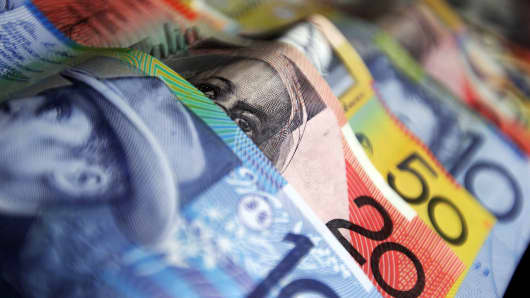Australia's central bank held its main cash rate at a record low of 3.0 percent on Tuesday, as expected, but left the door wide open for further easing if necessary to support the economy.
The Australian dollar dipped as the explicit easing bias surprised some. Investors had priced in only a limited chance of a cut from the Reserve Bank of Australia (RBA) so soon after its December move.
Indeed, RBA governor Glenn Stevens said the central bank judged it prudent to hold rates steady as the impact of past cuts had yet to be felt. He also pointed to signs of improvement in China and the United States, and to a pick-up in global markets in general.
Yet he also made it clear rates could go lower if needed.
"The Board's view is that with inflation likely to be consistent with the target, and with growth likely to be a little below trend over the coming year, an accomodative stance of monetary policy is appropriate," said Stevens. "The inflation outlook, as assessed at present, would afford scope to ease policy further, should that be necessary to support demand."
(Read More: You Just Can't Keep This Currency Down)
Financial markets had only seen a one-in-five chance of an easing this month, while a Reuters poll of 23 analysts had found all but one expected the RBA to hold steady
"It's clear that the easing bias is still there," said Su-Lin Ong, a senior economist at RBC Capital Markets.
"The bank remains hopeful that the amount of easing to date will see the non-resources part of the economy pick up, but we think they're being a little optimistic on that part," she added. "We still think they will cut in the second quarter."
Figures out earlier on Tuesday showed a jump in exports of iron ore and coal in December helped shrink the country's trade deficit. Importantly, spot prices for iron ore, Australia's single biggest export earner, have recovered strongly from an alarming drop last year which will underpin mining profits, tax receipts and economic growth in general.
Other data showed strong sales of commercial vehicles in both January and December, auguring well for business investment, while house prices rose by the most in over two years last quarter.
The RBA has cut rates in part to help revive activity in the moribund housing market, particularly for construction. So far, home building has not reacted nearly as strongly as during past easing cycles, but a pick-up in home prices could remedy that.
(Read More: Watch What Central Bankers Say, Not What They Do)
Markets suspect rates might be cut further given softness in parts of the domestic economy, especially those exposed to foreign competition and the high local dollar. Last year's 125 basis points of easing has yet to lead to much of a revival in borrowing.
Inflation has also been restrained by the lofty currency and retail discounting, with underlying inflation in the lower half of the RBA's long-term target band of 2 to 3 pct.
Analysts eye unemployment as one possible trigger for a further easing. The jobless rate was remarkably stable over 2012 but any sustained increase from the present 5.4 percent could warrant a move.


